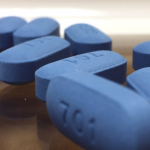Earlier this year, I was pleased to meet with more than 35 representatives of federal agencies engaged in implementing the National HIV/AIDS Strategy (NHAS). The NHAS Federal Implementation Workgroup (FIW) consists of representatives of the agencies that contributed to developing the strategy and who share responsibility for its implementation.
During the meeting, we reviewed the latest national HIV data from the Centers for Disease Control and Prevention (CDC), which are being used to monitor the 21 NHAS indicators of progress. The data, from 2022, indicate that we are going in the right direction in most cases. But the progress is incremental, and it varies across jurisdictions and demographic groups. Soon, additional data that are being used to monitor some of the indicators will be published. Later this year, we anticipate sharing an update on our progress toward the NHAS goals.
Members from 16 different agencies and offices shared updates about their work to pursue the action items detailed in the NHAS Federal Implementation Plan. Among the things we heard about:
- The Department of Justice’s continued work on HIV services in the Federal Bureau of Prisons, which have resulted in very high rates (>96%) of viral suppression among people in custody who have HIV;
- Recent work by the Department of Justice’s Civil Rights Division addressing both health care discrimination and HIV criminalization;
- Work by the Substance Abuse and Mental Health Services Administration across several programs to advance integration of behavioral and physical health, including HIV, STI [sexually trans-mitted infections] and viral hepatitis services;
- The Department of Veterans Affairs’ work to expand syringe services programs;
- The integration of people with HIV into programing led by the HHS [Health and Human Services] Administration on Community Living addressing social isolation and chronic disease self-management among older Americans;
- Technical assistance being offered by the Department of Housing and Urban Development to support communities in preparing for and swiftly responding to HIV outbreaks;
- New efforts within the Title X program to scale up HIV pre-exposure prophylaxis services offered at family planning clinics;
- CDC’s work to update guidelines on HIV screening in clinical settings, which will help providers know where to focus screening for most impact;
- Continued annual increases in the number of HIV tests at health centers and analysis indicating that about 19% of recent HIV PrEP users are being served by health centers as they have worked to scale up PrEP services;
- Collaborative work by Health Resources and Services Administration’s HIV/AIDS Bureau and the CDC over the past year on community engagement and current work to synthesize the themes from 14 regional listening sessions that will be shared with the community soon.
We also discussed initial plans to begin work on developing the 2026–2030 NHAS. The current Strategy continues through 2025. As we work together, we will be reflecting on the progress made under the current one; considering how best to incorporate new tools, policies and other assets into our work; and gathering input from state, tribal and local partners and members of the HIV community.







Comments
Comments